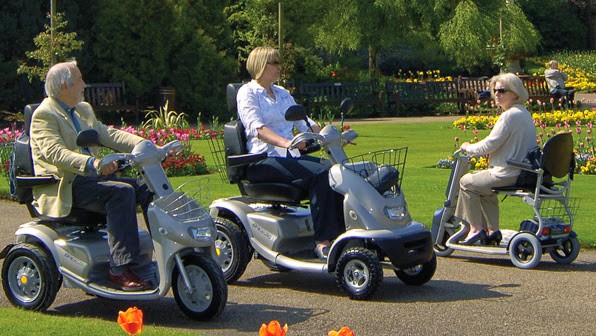Choosing the right mobility scooter
Choosing the right mobility scooter
There are many different mobility scooters for sale with a range of prices and specifications. At Accessible Madrid, we can help you narrow your choice, and stop you wasting your money, with the top considerations about using your scooter - such as daily use, where you're going to take it and the distances you?re likely to be travelling.
We will go straight to the reviews and which are the best buys. We will help you to choose the right mobility scooter.
A mobility scooter is a medical device as well as a lifestyle choice. It's important to get the right one for you - for example, with a tiller and controls you can operate if you have arthritic fingers Otherwise you could waste money or buy a scooter that isn't the safest or most comfortable.
Take advice from a mobility shop specialist before you make your final decision on what to buy. Which? Accessible Madrid has the advice on how to get an independent assessment.
Mobility scooters for the pavement
Scooters you can use to travel on pavements and in shopping areas. If you live near a high street and you can get to your destinations by avoiding roads, this may be a good choice.
This kind of scooters are smaller, lighter and often cheaper and can have three, four or, in some cases, five wheels. Three wheel scooters are very useful for indoors use, as the manouvre easily and better than a 4 wheel scooter. Three wheel scooters are recommended for those users who live in a building with small elevators.
Although some models are capable of much faster speeds, they should be driven at 6 km/h on pavements ? and some models may also allow you to cap the speed level to this legal limit.
Folding boot scooters
These are small mobility scooters, also for use on pavements only, that can be folded or taken apart for transporting. They are sometimes referred to as 'boot' scooters. If you can drive or have access to a car and you're looking for something to take you short distances, perhaps to go shopping in a town centre or for a day out with your family, a boot scooter can be a good choice.
There are two types: folding and dismantling. Folding scooters allow you to reduce them to a compact shape and wheel them, like a trolley. This makes them particularly convenient for air travel. Dismantling scooters are made up of four or five sections that have to be taken apart for travel or put together before they can be used.
Despite their portability, all models tend to be heavy to lift, so you are likely to need help lifting yours in and out of a car or arrange for someone else to do it for you. This is a particular issue with folding models, as normal practice is to lift them as one go. Removing the battery and armrests would reduce their weight by a couple of kilograms but they will remain heavy to lift. In contrast, dismantling models allow you to lift each component separately. However, you need to reassemble dismantling models, which you may find inconvenient.
Their being less powerful means that boot scooters are better suited to short journeys (normally of less than 20 kms). They are light and manoeuvrable and can be used indoors, but their smaller, less-padded seats often mean they're not as comfortable as larger models. Their wheels may also struggle with shallow kerbs.
Heavier mobility scooters
Heavier mobility scooters. They are larger and heavier than the small mobility scooters for the pavement cousins. You can drive them everywhere ? at speeds up to 12 km/h. Being more powerful, with bigger batteries, they are suited to longer journeys (up to 40 kms) and can cope better with hills. They have front and rear lights, indicators, hazard lights, a rear-view mirror, brakes and a horn. They tend to provide a more comfortable ride than some of the smaller scooters. These type of scooters are very comfortable as they have suspension. They are recommended for heavy users are they are more spacious and more powerful. Some models can be dismantled in smaller pieces so they can be easily transported.
Choosing a mobility scooter - top five things to consider:
- Place where you live (building with elevator, city with cobblestones, etc.)
- The types of journeys you plan to make
- The types of terrain you?ll cover
- Your storage facilities
- Your body weight and size
- Your budget
Place where you live
If you live in the city and your building has a small elevator, this will reduce your options to choose a scooter and you may have to decide between a foldable scooter or a three wheel scooter. In other cases, if you live in the countryside or your city has streets with cobblestones, you may have to choose an scooter with suspension and with pneumatic tires.
Types of journeys and terrains
When you are trying to decide on the type of mobility scooter you want, think about the sorts of journeys you're likely to make in it. Will they be short, everyday journeys, such as trips to the local supermarket or to visit a nearby friend or relative? If so, an small scooter will probably be right for you.
Will you mainly be using the scooter for days out with (perhaps able-bodied) friends or family? If so, a boot scooter that can be easily taken apart or folded and transported by car may be a better option.
Do you want to make longer journeys, perhaps to visit a neighbouring town, or do you live in a particularly hilly area? A heavier scooter that you can take on the road might make more sense.
The types of terrain you?ll cover
The type of terrain will tell you what kind of scooter suits you better. There are special scooters for those who live in the countryside or in cities with cobblestones. These scooters are normally bigger, include suspension and they are much powerful. If you live in a city with flat pavements you may only need a small/medium scooter with solid tires.
Your storage facilities
You should think about where you?ll keep your scooter when it?s not in use. If you can charge its battery separately, do you have somewhere dry and secure to keep it? If not, have you got room in your hallway or living areas to accommodate it?If you need to bring the scooter inside, you?ll need to think about whether you'll be able to get it in and out through doorways and find a model that can fit through the space available. Scooters that allow you to reduce the width of armrests or fold the tiller down may be more practical.
Medium and large-sized models are hefty items that normally need to be stored outside your home ? ideally in a garage or shed with a mains plug, so that the battery can be charged nightly. You may need to consider building ramps over steps to allow access.
Portable scooters and some of the smaller models can be dismantled or folded for storage and transporting, though you are unlikely to want to do this every time you use the scooter.
Your body weight and size
Get the mobility scooter weight right. Some of the smaller and lighter models have a maximum weight capacity ? around 95-140 Kilos for portable models. It?s important that you buy a mobility scooter suitable for your weight, because if you?re too heavy for the scooter it might become unstable. If you buy a scooter with a recommended weight capacity of lower than your actual weight, you will also invalidate the warranty.
Your budget
Once you have decided on the type you want, you may then want to look at price, distance range and appearance. At Accessible Madrid we sell products of the following manufacturers: Afiscooter, Drive Medical, Pride, Sunrise Medical, Apex, Luggie, Invacare, Kymco, Genny Mobility, Monarch, etc. We offer the best quality/price ratio in the market. Mobility scooter repair store. Come and visit us if you need advice or you just need to try a scooter. We have the most suitable scooter for you. We offer you all type of financing options.


